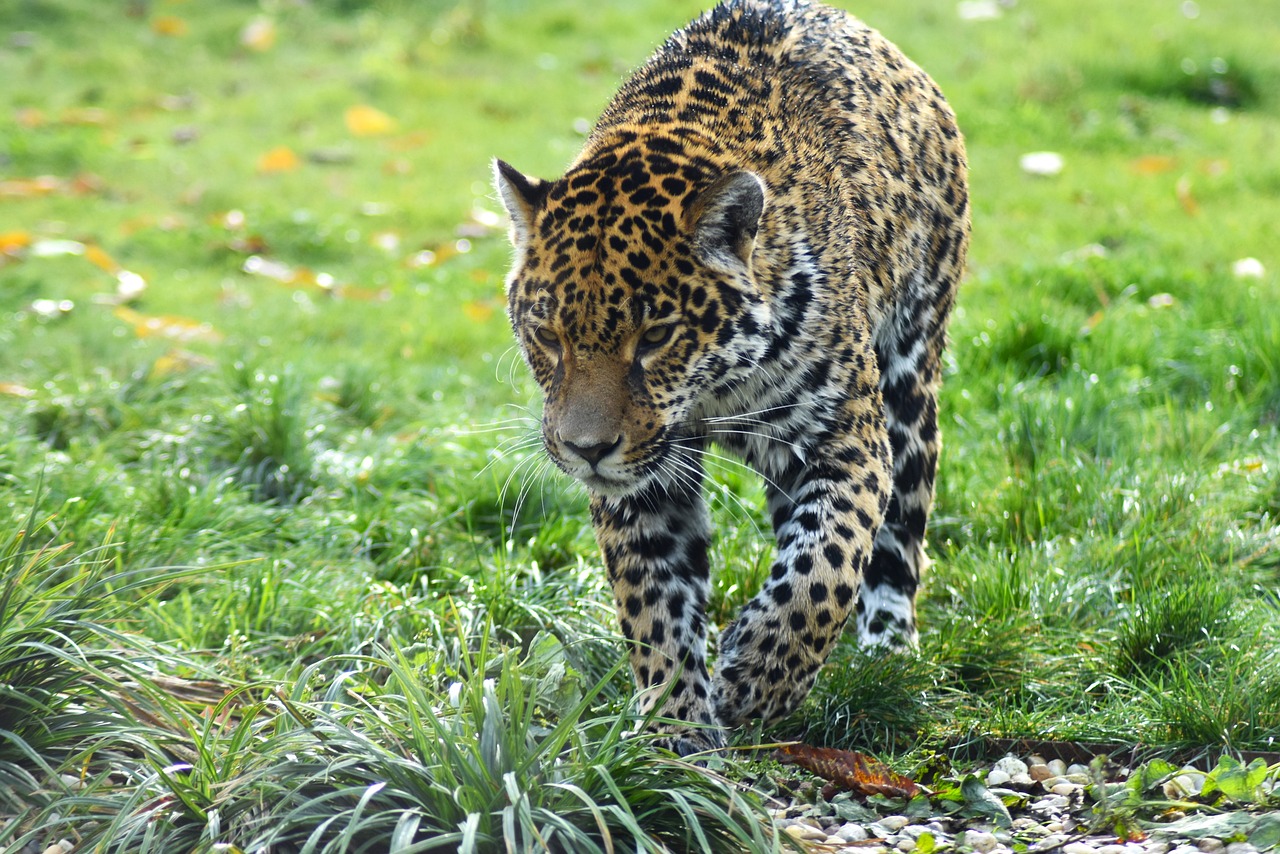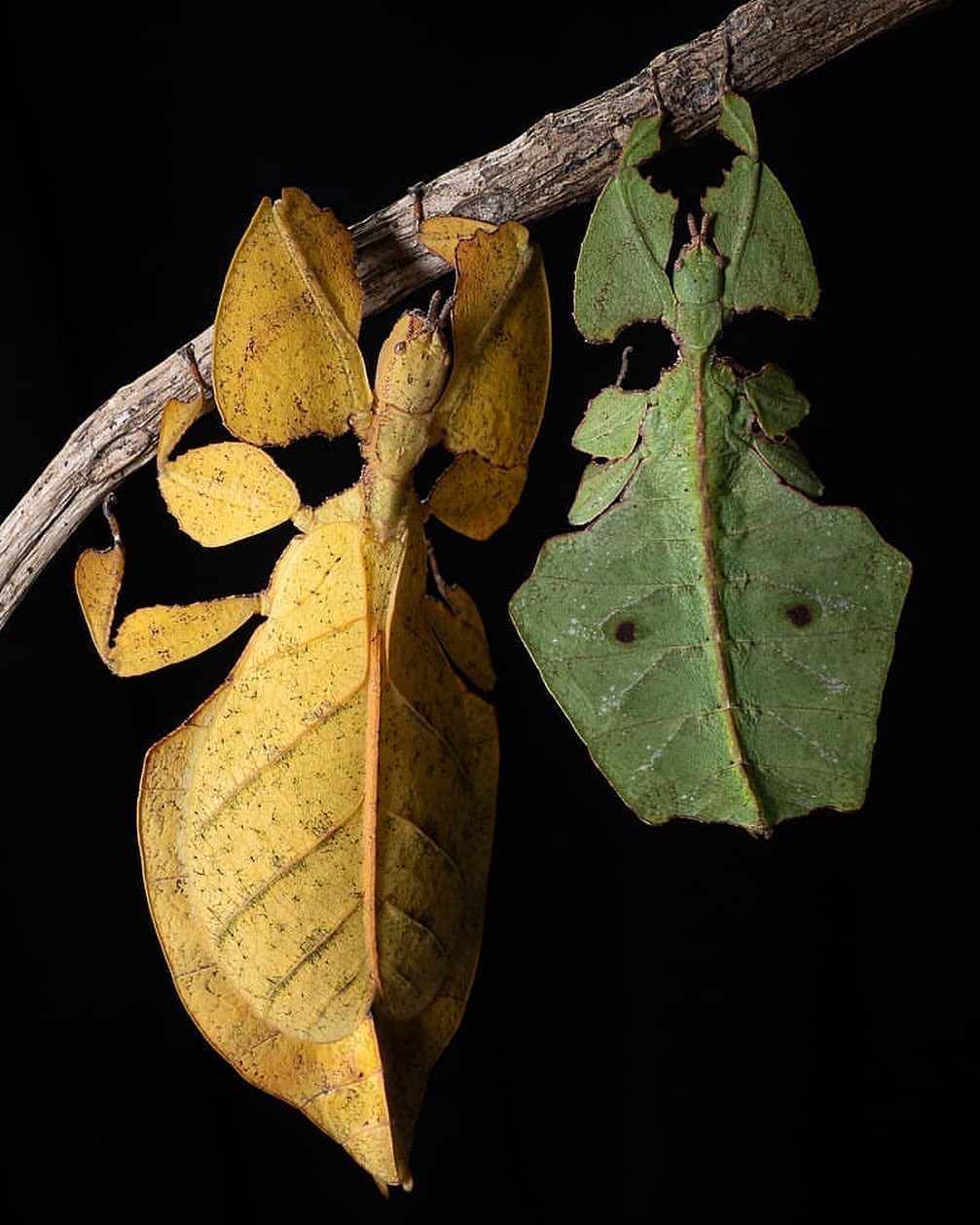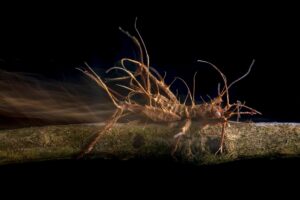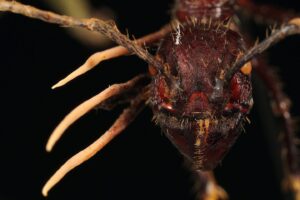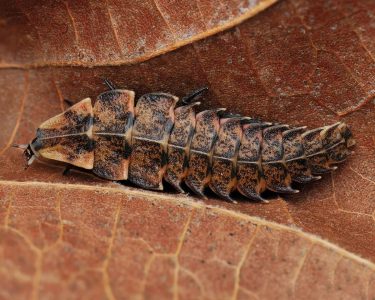 Pin
Pin Firefly Larva / Image by ishootbugs
It is a truth universally acknowledged that a warm summer evening must be in want of fireflies. There exists perhaps no sight more universally pleasing to the sensible observer than these delicate creatures, suspended in their ethereal dance, casting their gentle luminescence upon the darkened gardens and meadows of our countryside. Yet, dear reader, I must confess that even the most attentive among us remain quite ignorant of a most remarkable fact concerning these charming insects.
The fireflies that enchant our summer nights do not simply materialize from the ether, as one might fancy in a moment of romantic whimsy. Rather, they commence their earthly existence in a form so decidedly peculiar that it would scarcely be believed were it not verified by the most respectable natural philosophers. These infant beetles, known properly as baby firefly larva, spend considerable time in a state most humble and unexpected. They possess neither wings nor the capacity for flight, and yet they carry within them the same mysterious light that shall one day captivate our evening observations. These young creatures dwell in the soil and leaf litter, glowing softly in shades of blue and green whilst conducting their nocturnal pursuits quite beneath our notice. It is a most extraordinary transformation that awaits them.
Table of Contents
The Curious Metamorphosis of a Firefly
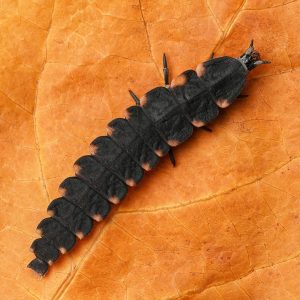 Pin
Pin Photo by Saga Optics
It must be understood, first and foremost, that fireflies are not flies at all, but rather beetles of the most distinguished variety. They belong to the family Lampyridae, a name derived from the Greek word for torch, which speaks most eloquently to their illuminating capabilities. The transformation these creatures undergo from their infancy to their celebrated adulthood is nothing short of remarkable, though it requires a patience that would try even the most steadfast of souls. Whilst butterflies complete their metamorphosis in a matter of weeks, fireflies may spend upwards of two years in their larval state, dwelling in the soil like tiny hermits before emerging into society. During this protracted period of development, they are engaged in the serious business of survival, hunting prey with an efficiency that would impress even the most skilled of sportsmen.
The larval stage represents not merely a phase of waiting, but rather a period of considerable activity and growth. These young beetles must consume sufficient nourishment to sustain themselves through their transformation, and nature has equipped them admirably for this purpose. They possess strong mandibles and a rather unsettling appetite for creatures smaller than themselves. One might observe that they approach their hunting with the same methodical determination that a young lady might apply to mastering the pianoforte—with practice, persistence, and an unwavering focus upon their objective. The larva increases in size through a series of molts, shedding its outer covering much as one might change one’s attire for different occasions, until it has achieved the proper dimensions for its eventual metamorphosis into the winged creature we so admire.
The Appearance of These Peculiar Younglings
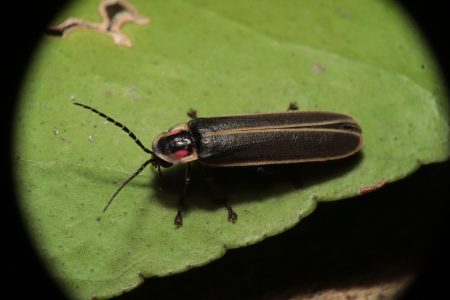 Pin
Pin Firefly / Image by Francisco Corado Rivera from Pixabay
Should one happen upon a firefly larva during a nighttime ramble through the garden, one might be forgiven for mistaking it for a rather common worm or beetle grub. These creatures measure approximately half an inch in length when fully grown, though they begin their lives considerably smaller. Their bodies are composed of segmented sections, rather like a lady’s articulated bracelet, each segment bordered by a darker edge that gives them a somewhat armored appearance. The coloration tends toward brown or grey, which serves them excellently in their subterranean habitats, allowing them to move about undetected by predators who might otherwise find them a tempting morsel. What distinguishes them most remarkably from ordinary beetle larvae, however, is the soft glow emanating from their lower segments—a ghostly luminescence that has earned them the charming, if somewhat fanciful, appellation of “glow-worms.”
The texture of their bodies is neither smooth nor particularly pleasant to contemplate for those of delicate sensibilities. They possess a leathery quality, somewhat flattened in aspect, which enables them to navigate through narrow spaces between soil particles and beneath fallen leaves with admirable ease. Their heads are equipped with powerful jaws that curve inward like tiny sickles, designed for a purpose we shall explore presently. Six small legs protrude from the front portion of their bodies, though these appendages appear almost comically inadequate for the work they must perform. Yet nature, in her infinite wisdom, has fashioned these creatures precisely as they need to be for their particular station in life. They move with a deliberate, undulating motion, somewhat reminiscent of a caterpillar’s progress, though perhaps with less grace and more determination about their manner.
The Illuminating Question of Why They Glow
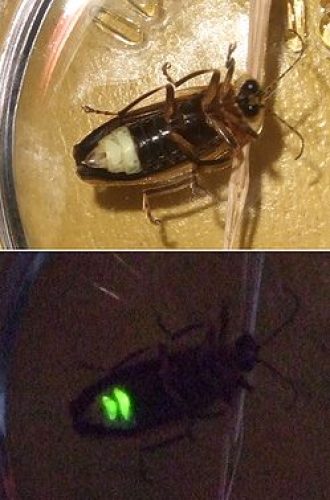 Pin
Pin Firefly / Image from Wikimedia Commons
One cannot help but wonder, upon learning of these luminous larvae, what purpose such a light might serve for a creature dwelling in the darkness of the soil. It would seem, at first consideration, rather imprudent for a young insect to advertise its presence so conspicuously to any predator that might be passing by. Yet nature, as we have observed time and again, rarely indulges in frivolity without excellent reason. The glow of the firefly larva serves as a warning signal, much as a brightly colored waistcoat might announce a gentleman of particular fashion sensibilities.
This phenomenon, which natural philosophers term aposematism, communicates a most urgent message to potential predators: I am not a palatable choice for your supper. The larvae contain certain chemical compounds that render them distasteful, even toxic, to birds and other creatures who might otherwise consider them a convenient meal.
The light itself is produced through a chemical reaction of extraordinary efficiency, one that has captivated scientists for generations and continues to perplex them even in our modern age. Within specialized cells called photocytes, a substance named luciferin combines with oxygen in the presence of an enzyme called luciferase, producing light with almost no heat whatsoever. This stands in marked contrast to our candles and lamps, which waste considerable energy in the production of warmth. The larva can control this glow with remarkable precision, dimming or brightening it according to circumstance, much as one might adjust the curtains to regulate the sunlight entering a drawing room. While adult fireflies employ their flashing patterns for the romantic purpose of attracting mates, the larvae use their steady glow purely for protection, maintaining their luminescence throughout the night as they go about their necessary business in the leaf litter and soil.
The Rather Carnivorous Habits of These Young Beetles
It may come as something of a shock to those who regard fireflies with sentimental affection to learn that their offspring are quite decidedly predatory in nature. The larva does not subsist upon leaves or nectar, as one might hope of such an enchanting creature’s progeny, but rather pursues a diet consisting entirely of other small invertebrates. Their preferred quarry includes snails, slugs, and earthworms—creatures that, while perhaps not inspiring great sympathy in most observers, are nevertheless going about their own business with perfect innocence when they encounter these glowing hunters. The larva employs a hunting method that is both fascinating and rather unsettling to contemplate, one that speaks to nature’s remarkable ingenuity in matters of survival, however brutal they may appear to our more refined sensibilities.
When a firefly larva locates a suitable victim, it does not simply bite and consume in the manner one might expect of a conventional predator. Instead, it delivers a series of small bites, injecting digestive enzymes directly into the unfortunate creature’s body through those curved mandibles we mentioned earlier. These enzymes work with extraordinary efficiency, liquefying the internal tissues of the prey from within, transforming solid matter into a nutritious soup that the larva can then consume at its leisure. This process, which scientists term extra-oral digestion, allows the larva to feed upon creatures considerably larger than itself, much as a determined younger sibling might somehow manage to claim the largest portion at dinner despite their diminutive size. The entire procedure may take several hours, during which the larva remains attached to its prey, periodically injecting more enzymes and drawing out the liquefied nourishment. It is nature’s way, though perhaps not the most genteel dinner conversation one might imagine.
Where One Might Discover These Hidden Creatures
The habitats favored by firefly larvae are precisely those places where moisture, shelter, and an abundance of prey converge in felicitous harmony. One is most likely to encounter them in gardens where the soil remains consistently damp, in woodlands carpeted with decaying leaves, and along the margins of streams or ponds where the earth never quite dries completely. They show a marked preference for areas where human interference has been minimal, as they require the thick layer of organic matter that accumulates naturally when leaves and plant debris are permitted to remain undisturbed through the seasons. This presents something of a dilemma for those who maintain their gardens with fastidious attention, for the very tidiness that pleases the eye often removes the precise conditions these larvae require for their survival.
The young beetles tend to position themselves in the upper layers of soil and leaf litter, rarely venturing more than a few inches below the surface, as they must have access to adequate moisture whilst also remaining within reasonable distance of their prey. During daylight hours, they take shelter beneath logs, stones, or within the dense mat of decomposing vegetation, emerging only after darkness has fallen to conduct their nocturnal hunting expeditions. They are creatures of habit and routine, much like a country gentleman who follows the same walking path each evening after supper. In regions where winters bring cold temperatures, the larvae burrow deeper into the soil to escape the frost, entering a state of dormancy until warmer weather returns and awakens both them and their potential prey. This cyclical pattern of activity continues for the entirety of their larval period, which may span one or two years depending upon the species and the prevailing conditions of their environment.
The Transformation from Crawler to Flyer
When the larva has at last achieved sufficient size and stored adequate reserves for the monumental change ahead, it enters what natural philosophers call the pupal stage. This represents a period of profound transformation, though it occurs with far less fanfare than one might expect of such a dramatic metamorphosis. The larva seeks out a protected location, often a small cavity in the soil or beneath a piece of bark, and there constructs a chamber where it shall remain undisturbed during its reconstruction. Unlike the elaborate chrysalis of a butterfly, which hangs suspended like a jeweled pendant, the firefly pupa is a modest affair, scarcely distinguishable from the earth surrounding it. Within this humble chamber, the creature’s body undergoes a reorganization so complete that were we able to observe it, we should scarcely credit the evidence of our own eyes.
The pupal period typically extends for two to three weeks, during which time the segmented, crawling form gradually resolves itself into something altogether different. Wings begin to form where none existed before, folded neatly against the developing body like a lady’s fan tucked into her reticule. The hunting mandibles of youth give way to more modest mouthparts, for the adult firefly has little interest in feeding and may not eat at all during its brief aerial existence. The light-producing organs relocate to the abdomen and become capable of producing the flashing patterns that shall soon serve the most important purpose of the beetle’s adult life—the attraction of a suitable mate. When the transformation is complete, the newly formed adult beetle emerges from the soil, spreads its wings for the first time, and takes to the air. It is a moment of singular triumph, the culmination of years spent in patient darkness, now rewarded with the freedom of flight and the warm glow of summer evenings.
The Brief and Passionate Adult Life
The adult firefly emerges into a world entirely different from the one it knew as a larva, and its priorities shift with remarkable swiftness from the practical concerns of feeding and survival to the singular imperative of reproduction. Most adult fireflies live for only a few weeks, perhaps a month if fortune smiles upon them, which stands in stark contrast to the year or two they spent in their larval form. During this abbreviated existence, they have but one essential purpose: to find a mate, reproduce, and ensure the continuation of their species. It is rather like attending a grand ball where one has only the briefest opportunity to make an impression and secure a dance partner before the evening concludes forever. The urgency of their situation informs every aspect of their behavior, and the luminous displays we so admire are, in essence, desperate advertisements placed in the night sky.
The courtship rituals of fireflies are conducted entirely through the medium of light, with each species employing its own distinctive pattern of flashes that serves as a kind of aerial code. The males typically fly about, flashing their signals in hopes of attracting a female’s attention, whilst the females perch upon vegetation and respond with their own answering flashes if they find a suitor acceptable. The timing, duration, and intensity of these flashes must be precise, for a female can distinguish between the signals of her own species and those of others with remarkable accuracy. Once a pair has located one another through this luminous correspondence, they mate, and the female subsequently lays her eggs in moist soil or amid the leaf litter, carefully selecting locations where her offspring shall have the best prospects for survival. With this duty discharged, the adult fireflies expire, their brief moment of glory concluded, leaving behind the promise of a new generation that shall once again begin the long journey from glowing larva to flying beacon.
The Perils Facing These Luminous Creatures
The modern world presents considerable challenges to fireflies at every stage of their development, though perhaps none so acutely as during their vulnerable larval period. The loss of suitable habitat represents the most pressing concern, for as we have established, these young beetles require specific conditions that are increasingly difficult to find in landscapes dominated by human activity. When property owners remove fallen leaves, apply pesticides to their lawns, or drain wetlands for development, they inadvertently eliminate the very environments upon which firefly larvae depend. The larvae cannot simply relocate to more favorable conditions, as their limited mobility confines them to relatively small territories. A larva that finds itself in unsuitable habitat has no recourse but to perish, and thus entire local populations may vanish when their habitat is altered or destroyed, much as a family of modest means might find themselves without prospects when their ancestral estate is sold.
Light pollution, that peculiar affliction of our modern age, poses an additional threat that affects both larvae and adults, though in different ways. Whilst the larvae themselves are not directly harmed by artificial illumination, the adults require darkness to conduct their courtship displays effectively. When streetlights, porch lamps, and the general glow of urban areas illuminate the night, the delicate flashing signals of fireflies become lost in the ambient brightness, rather like attempting to conduct a whispered conversation in a crowded ballroom. Males cannot locate females, females cannot properly evaluate potential mates, and the entire reproductive process suffers accordingly. This means fewer eggs are laid, fewer larvae hatch, and populations gradually decline. Chemical pesticides present yet another hazard, as these substances designed to eliminate unwanted insects make no distinction between pest and treasure, destroying firefly larvae along with their intended targets. The cumulative effect of these various threats has resulted in concerning declines in firefly populations across many regions.
How One Might Assist These Remarkable Creatures
Those who find themselves moved by the plight of fireflies and wish to offer assistance need not possess extensive scientific knowledge or vast estates to make a meaningful difference. The most valuable contribution one can make begins in one’s own garden or yard, where even modest changes in maintenance practices can create hospitable conditions for larvae. The key lies in resisting the modern impulse toward excessive tidiness and allowing nature a bit of liberty to conduct her affairs as she sees fit. When autumn leaves fall, permit at least some portion of them to remain where they land rather than removing every last fragment. These leaves shall decompose slowly over the winter months, creating precisely the sort of moist, sheltered environment that firefly larvae require. Similarly, allowing grass to grow somewhat longer in certain areas provides additional cover and maintains moisture in the soil beneath, whilst also supporting the populations of snails and other small creatures upon which the larvae feed.
The elimination or significant reduction of pesticide use represents another crucial step toward creating firefly-friendly habitat. One must consider that any chemical applied to control mosquitoes, grubs, or other perceived nuisances will almost certainly affect firefly larvae as well, for they are no less vulnerable to these substances than the insects one wishes to eliminate. There exist alternative methods for managing garden pests that do not involve broadcasting poisons across one’s property, and these gentler approaches benefit not only fireflies but the entire community of beneficial insects that contribute to a healthy garden ecosystem. Additionally, one might consider reducing outdoor lighting during the summer months when fireflies are most active, perhaps extinguishing porch lights after retiring for the evening or installing motion sensors that illuminate pathways only when necessary. These small acts of consideration, multiplied across many households, can create corridors of darkness where fireflies might once again conduct their courtship undisturbed, much as thoughtful neighbors might lower their voices to allow a musical performance to be heard.
The Scientific Study of These Glowing Larvae
The study of firefly larvae has occupied the attention of natural philosophers and scientists for generations, though it must be acknowledged that these creatures have not received the same degree of scholarly scrutiny as their more glamorous adult counterparts. The difficulty lies partly in the challenge of observing subjects that spend their entire youth concealed beneath soil and leaves, emerging only under cover of darkness to conduct their affairs. Early naturalists who wished to study these larvae were obliged to sift through considerable quantities of leaf litter and soil, hoping to chance upon specimens, and even when successful, they found the creatures remarkably difficult to maintain in captivity. The larvae require specific conditions of moisture and temperature, along with a steady supply of live prey, which presents considerable logistical complications for researchers attempting to observe their development over the extended period of months or years that their larval stage encompasses.
Modern scientific investigation has revealed extraordinary details about the biochemistry of bioluminescence that earlier naturalists could scarcely have imagined. Researchers have isolated and studied the luciferin and luciferase compounds responsible for the larvae’s glow, discovering that this biological light production operates with an efficiency that far surpasses any artificial illumination humans have yet devised. Indeed, scientists and engineers have looked to firefly larvae as inspiration for developing new lighting technologies and medical imaging techniques, for the same chemical reaction that allows a larva to glow in the darkness might be adapted to illuminate cancer cells or track the spread of infections within the human body. Additionally, studies of larval behavior and ecology have contributed to our understanding of predator-prey relationships and the importance of maintaining diverse, layered habitats in natural environments. Each discovery adds another thread to our comprehension of these creatures, revealing them to be far more complex and worthy of admiration than one might suppose from their humble appearance.
The Enduring Wonder of These Hidden Lives
There exists something profoundly humbling in the realization that beneath our feet, as we walk through gardens and woods on warm summer evenings, entire dramas of survival and transformation are unfolding in complete obscurity. The firefly larvae we have come to know through these pages spend the greater portion of their lives in a realm we rarely consider, moving through darkness with their gentle glow, hunting their prey with patient determination, and preparing themselves for a metamorphosis that will grant them mere weeks of aerial existence. This disproportion between their long preparation and brief culmination invites philosophical reflection, for it speaks to the curious economy of nature, which invests years of effort for fleeting moments of glory. Yet those moments, when adult fireflies illuminate our summer nights with their courtship displays, carry forward the entire purpose of those hidden years, ensuring that new generations of larvae shall continue the cycle in their own time.
The next occasion you find yourself fortunate enough to witness fireflies dancing through the dusk, perhaps you shall regard them with enhanced appreciation, knowing now the extraordinary journey each one has undertaken to reach that moment. They are not simply charming insects that appear spontaneously to decorate our evenings, but rather the triumphant result of a prolonged and perilous existence spent largely underground. The larvae glowing softly in the leaf litter, the pupae transforming in their earthen chambers, and the adults flashing their luminous codes across the darkness are all participants in one continuous story of adaptation and survival. By understanding and protecting these creatures at every stage of their remarkable lives, we preserve not merely a species of beetle, but a living connection to the natural world that has enchanted humans for countless generations and shall, we must hope, continue to do so for many generations yet to come.
FAQs
Most firefly larvae spend one to two years in their larval form before pupating and transforming into adults, which then live only a few weeks.
Firefly larvae pose no danger to humans whatsoever. Their mandibles are designed exclusively for their tiny prey such as snails and slugs.
Indeed, most firefly larvae possess the ability to produce light, though the intensity varies between species and some glow more dimly than others.
They are often called glow-worms, though this name also applies to other bioluminescent beetle larvae. Firefly larva remains the most accurate term.
They can flourish if conditions suit them—particularly if leaf litter remains undisturbed, pesticides are avoided, and moisture is maintained in the soil.





